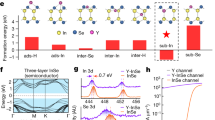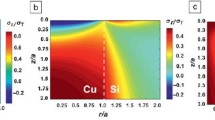Abstract
Ultralarge-scale integrated circuits (ULSICs) are fabricated in a single crystal of silicon using submicron device structures arrayed in two dimensions, which are interconnected in the third dimension with multilevel metallizations. The latter use several alternating layers of metal and dielectric films. Currently, four-level metallizations are used in large volume ULSIC manufacturing. As the technologies advance in ULSICs and beyond, four-level metallizations are expected to increase to six-level and higher. In three-dimensional ICs (3-D ICs) and ultraperformance ICs (UPICs), in which active devices are also fabricated in the third dimension in addition to the interconnects, the total number of semiconductor, dielectric, and metal films increases significantly. The thermophysical properties of all of these films play an ever-increasing role in the overall yield, reliability, and chip size of the ICs. The thermophysical properties considered in this paper are the thermal conductivity κ and the stress σ and its variations on thermal cycling, of the SiO2 films only. Data for these parameters are shown, with comments on their impact on the reliability of the ICs, and the role of Umklapp and point defect scattering mechanisms on the κ of thin films is discussed. The thermophysical properties not only are important in the current ULSICs for enhanced performance and reliability, but are even more crucial for the design and manufacturing of the next generation ICs like 3-D ICs and UPICs.
Similar content being viewed by others
REFERENCES
P-6 Processor, Intel Corporation (1995).
A. N. Saxena, VMIC State-of-the-Art Seminar (1989), p. 8; A. N. Saxena, K. Ramkumar, S. K. Ghosh, and M. A. Bourgeois, Proc. IEEE Bipolar/BiCMOS Circuits Technol. Meet. (BCTM), Minneapolis, MN (1993), p. 12.
A. N. Saxena and M. Bourgeois, Proc. 11th Int. VMIC (1994), p. 126.
N. Savvides and H. J. Goldsmid, Phys. Lett. 41A:93 (1972).
A. N. Saxena, in Mittal Festschrifft, W. J. van Ooij and H. R. Anderson, Jr, eds. (VSP International Science, Zeist, The Netherlands, 1997), p. 1.
J. R. Black, IEEE Proc. IRPS (1982), p. 300.
H. A. Schafft, IEEE Trans. Electronic Devices, ED-34, (1987), p. 3.
K. Ramkumar and A. N. Saxena, J. Electrochem. Soc. 139:1437 (1992).
A. N. Saxena, K. Ramkumar, and S. K. Ghosh, Proc. 11th Int. VMIC (1994), p. 252.
A. N. Saxena, Proc. 12th Int. VMIC (1995), p. 430.
Rights and permissions
About this article
Cite this article
Saxena, A.N. Importance of Thermophysical Properties of Thin Films in Ultra-Large-Scale Integrated Circuits and Beyond. International Journal of Thermophysics 19, 961–967 (1998). https://doi.org/10.1023/A:1022615728230
Issue Date:
DOI: https://doi.org/10.1023/A:1022615728230




